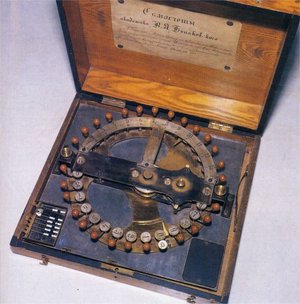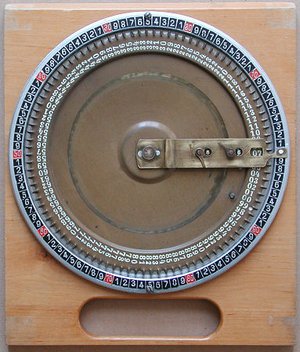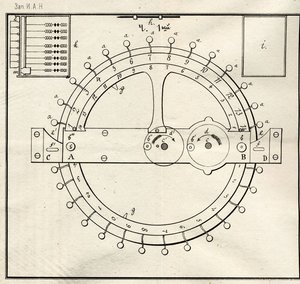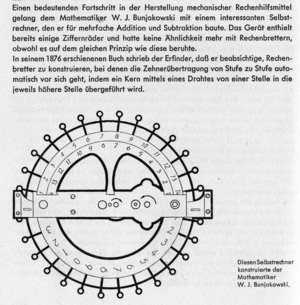Kreisrechner Bunjakowski
|
1 Maschinendaten
Modell............:
Firma.............: unbekannt
Hersteller*.......: unbekannt ...
Ort, Land.........: Russland
Maße (LxBxH)......:
Maße (LxBxH)......:
Gewicht...........: g
Stellen...........:
Eingabe mit.......: Tasten
Antrieb...........:
Löschung..........:
System............: Kreisrechner
Farbe(n)..........:
Material..........:
Produziert........: 1867
2 Beschreibung
Das gezeigte Modell wird im Polytechnischen Museum Moskau aufbewahrt. Es ist das einzige bekannte Exemplar. (Man beachte das kleine Rechenbrett links vorn). Eine Abbildung findet sich in Pribory_I_Instrumenty Foto 12. Die Maschine wird dort 'Samostschoty von Bunjakowski' bezeichnet.
Zum Aufbau:
In 1867, Bunyakovskiy made an adding machine, which he called "Samoschoty" (Auto-Abacus), mainly for census needs. It was a revolving metal ring with the numbers from 0 to 9, written on its outer edge three times. A handle in the shape of a small curved shaft tipped with a ball (of bone) was attached to it near each number. Two rows of numbers from 1 to 14 in big and small characters are written on the upper half of the ring. The big numbers are set in an increasing order, while the small numbers are set into decreasing order (14 to 1). The big numbers are used for addition, whereas the small numbers are used for subtraction. A metal plank with reading windows is placed over the ring along its diameter and fixed to the unmovable part of the device. On the plank, there are also 'reading pinions' with handles, which are used for setting the ring into the initial (zero) position. There is a tooth on the ring placed between numbers 0 and 9 (three teeth altogether) which touches the right reading pinion, turning it one tooth at a time. The corresponding number appears in the reading window. The mechanism is mounted in a wooden box, in which the little abacus and blackboard are also placed. Numbers smaller than 14 could be
added (subtracted) directly, but the operations with bigger numbers were performed in the first decimal places, then in the second, etc., rank by rank. The counter's total capacity was 999. By adding one more wheel, it could be easily increased to 9999, etc.
(Aus Igor A. Apokin: Bunyakovskiy and his "Auto-Abacus" translated by Alexander Y. Nitussov; Dank an Timo Leipälä für den Beitrag)
Besonderheiten....:
Varianten.........:
Konstrukteur*.....: Bunjakowski
Designer..........:
3 Literatur
- Pribory_I_Instrumenty von Majstrow & Petrenko, Foto 12. In diesem Buch wird auf Foto 13 eine weitere Rechenmaschine als 'Abänderung des Samostschoty von Bunjakowski' bezeichnet. Timo Leipälä schreibt hierzu "Wenn ich den Text von Majstrow & Petrenko richtig verstehe, behaupten sie nicht, dass der Rechner (ihr Foto 13) ähnlich Adall & Hauff von Bunjakowski entworfen wurde. Sie schreiben nur, dass dieser Rechner eine Änderung und eine Verbesserung von B.s originalem Selbstrechner ist, aber sie machen keinerlei Angaben über den Hersteller oder das Alter des Rechners. Die einzigen Angaben (Seite 54) betreffen die Grösse 24.5 x 21 x 0.7 cm des Rechners und die zwei bekannten Besitzer (Majstrow selbst und das Museum von Petrozawodsk)... Ich glaube nicht dass der Rechner in Russland hergestellt wurde" (übersetzt). (Siehe hierzu auch das nebenstehende Bild).
Die Identität des unbekannten Kreisrechners ist inzwischen geklärt, es handelt sich um eine unbenannte Addierscheibe von Albert Hauff.
- Das Bild rechts zeigt eine Skizze aus B.s Beschreibung seines Kreisrechners
(W. Ja. Bunjakowskij: "O Samoschetakh i o nowom ikh primenenija", 1876, 28 S)
(Ergänzung von Timo Leipälä)
- Bunjakowski Kreisrechner
(aus Kobrinski / Pekelis 1961
Man beachte den Hinweis auf eine
weitere Idee von Bunjakowski
4 Bemerkungen
5 Patente
6 Literatur
- Siehe auch Shilov 2015
7 Weblinks
8 Seriennummern
- Seriennummern:
- Nummernlagen:
9 Allgemeine Anmerkungen
Seite eröffnet von: stewe 20:59, 6. Jul 2006 (IST)
Diese Seite darf an allen Stellen ergänzt werden,
die noch leer sind. Außerdem dürfen Zeilen hinzu gefügt werden.
Falls Sie mit einem bestehenden Inhalt nicht einverstanden sind,
machen Sie bitte einen Eintrag bei der Diskussion und schicken dem Ersteller der Seite eine Mail.
![[Hauptseite]](/upload/wiki.png)
 Hauptseite
Hauptseite




 siehe unten
siehe unten